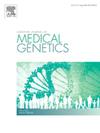Mirror syndrome and placental ectopic liver in association with de novo SOS1 variant
IF 1.7
4区 医学
Q3 GENETICS & HEREDITY
引用次数: 0
Abstract
Mirror syndrome is a rare obstetric condition characterized by maternal fluid retention mirroring fetal hydrops. Placental ectopic liver tissue is an extremely rare non-trophoblastic placental tumor, potentially arising from aberrant hepatoblast migration. While its association with fetal hydrops has been reported, the clinical significance remains uncertain. We present a patient of maternal mirror syndrome linked to fetal hydrops due to a de novo SOS1 variant, with histopathological identification of placental ectopic liver tissue.
A 32-year-old woman was admitted at 31 weeks’ gestation with fetal hydrops, presenting with bilateral pleural effusions, ascites, and subcutaneous edema. Due to worsening maternal pleural effusion, she was transferred to our hospital at 31 weeks and 6 days. Given progressive maternal and fetal deterioration, an emergency cesarean section was performed at 32 weeks due to concerns regarding maternal mirror syndrome. The female infant was delivered with severe respiratory distress and succumbed at 9 days of age. Trio-based exome sequencing identified a de novo heterozygous SOS1 variant (NM_005633.4:c.512T > A [p.V171G]), confirming a postmortem diagnosis of Noonan syndrome. Histopathological analysis of the placenta revealed ectopic liver tissue within the villi, confirmed by positive immunostaining for hepatocyte markers. A recent report of RIT1-associated mirror syndrome and non-immune hydrops fetalis (NIHF) further supports the role of Rasopathies in the pathogenesis of mirror syndrome.
Our findings confirm that mirror syndrome is a potential manifestation of Rasopathies, while the role of ectopic liver tissue in the placenta remains uncertain. Future research should focus on genetic factors underlying mirror syndrome rather than incidental placental anomalies.
镜像综合征和胎盘异位肝与新生SOS1变异相关。
镜像综合征是一种罕见的产科疾病,其特征是母体液体潴留反映胎儿积液。胎盘异位肝组织是一种极为罕见的非滋养细胞性胎盘肿瘤,可能由肝母细胞异常迁移引起。虽然它与胎儿水肿的关系已被报道,但临床意义仍不确定。我们提出了一个病人的母体镜像综合征与胎儿积液由于一个新的SOS1变异,与组织病理学鉴定胎盘异位肝组织。一位32岁的女性在妊娠31周时因胎儿水肿入院,表现为双侧胸腔积液、腹水和皮下水肿。因母体胸膜积液加重,于31周零6天转至我院。考虑到母体和胎儿的恶化,由于担心母体镜像综合征,在32周时进行了紧急剖宫产手术。女婴出生时出现严重呼吸窘迫,于9日龄死亡。三基外显子组测序鉴定出一个全新的杂合SOS1变异(NM_005633.4:c)。512 t > [p。V171G]),确认死后诊断为努南综合征。胎盘组织病理学分析显示绒毛内异位肝组织,肝细胞标记物免疫染色阳性证实。最近关于rit1相关镜像综合征和非免疫性积水胎儿(NIHF)的报道进一步支持Rasopathies在镜像综合征发病机制中的作用。我们的研究结果证实,镜像综合征是Rasopathies的潜在表现,而异位肝组织在胎盘中的作用仍不确定。未来的研究应关注镜像综合征的遗传因素,而不是偶然的胎盘异常。
本文章由计算机程序翻译,如有差异,请以英文原文为准。
求助全文
约1分钟内获得全文
求助全文
来源期刊
CiteScore
4.10
自引率
0.00%
发文量
193
审稿时长
66 days
期刊介绍:
The European Journal of Medical Genetics (EJMG) is a peer-reviewed journal that publishes articles in English on various aspects of human and medical genetics and of the genetics of experimental models.
Original clinical and experimental research articles, short clinical reports, review articles and letters to the editor are welcome on topics such as :
• Dysmorphology and syndrome delineation
• Molecular genetics and molecular cytogenetics of inherited disorders
• Clinical applications of genomics and nextgen sequencing technologies
• Syndromal cancer genetics
• Behavioral genetics
• Community genetics
• Fetal pathology and prenatal diagnosis
• Genetic counseling.

 求助内容:
求助内容: 应助结果提醒方式:
应助结果提醒方式:


